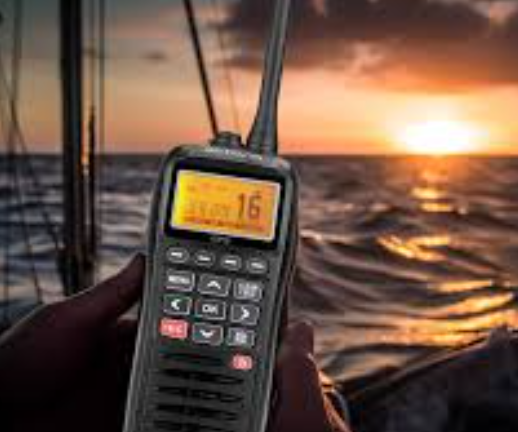Picture this: You’re out on the open water, feeling the wind in your hair and the sun on your face. The waves gently rock your boat as you navigate the vast expanse of the sea. But in the midst of this peaceful serenity, there may come a time when you need to communicate with other boats or send out a distress signal. Knowing the basics of using marine radios and distress signals is crucial for any boater, ensuring your safety and the safety of others around you. In this article, we’ll explore the essential knowledge and techniques you need to effectively use marine radios and distress signals on your boat. So grab your life jacket and let’s set sail into the world of maritime communication.
Basics of Marine Radios
Marine radios are essential communication devices used by boaters to ensure safety and effective communication while out on the water. These radios enable boaters to communicate with other nearby vessels, local authorities, and even emergency responders in case of any emergencies. Understanding the basics of marine radios is crucial for every boater, whether you’re a seasoned captain or a novice sailor.
Types of Marine Radios
There are two main types of marine radios: Very High Frequency (VHF) marine radios and Single Sideband (SSB) marine radios. VHF marine radios are the most common type used by recreational boaters due to their range and reliability. SSB marine radios, on the other hand, provide long-range communication capabilities and are often used by commercial vessels and long-distance sailors.
Range of Marine Radios
The range of marine radios depends on various factors, including the output power of the radio and the height of the antenna. Typically, a VHF marine radio has a range of about 5 to 25 nautical miles, although this range can be extended by using specialized antennas or repeater stations. SSB marine radios, with their long-range capabilities, allow communication over hundreds or even thousands of nautical miles, depending on atmospheric conditions and the power output of the radio.
Operating Procedures for Marine Radios
To ensure effective and efficient communication, it is important to follow proper operating procedures when using marine radios. First and foremost, you should always monitor channel 16, which is the international hailing and distress frequency. This allows you to be aware of any emergency situations and respond accordingly. When making a radio call, it is important to clearly state the vessel you are trying to communicate with, your own vessel’s name, and the nature of your communication.
VHF Marine Radios
VHF marine radios are the most commonly used type of marine radios among recreational boaters due to their simplicity and effectiveness. They operate within the Very High Frequency range and provide reliable short-range communication capabilities.
Features of VHF Marine Radios
VHF marine radios offer a range of features that enhance safety and ease of use. One of the key features is the ability to select different channels, ranging from channel 6 to channel 88. Each channel serves a specific purpose, such as hailing, distress calling, weather information, or ship-to-ship communication. Additionally, VHF marine radios often include Digital Selective Calling (DSC) capabilities, which enable boaters to send automated distress signals and make direct calls to specific vessels.
Channel Usage on VHF Marine Radios
Different channels on VHF marine radios are designated for specific purposes. Channel 16, as mentioned earlier, is used for hailing and distress calls. Channel 9 is commonly used for recreational boating communication and non-emergency purposes. Other channels are allocated for weather information, ship-to-ship communication, and working channels for commercial vessels. It is important to familiarize yourself with the channel allocation and use the appropriate channels for clear and effective communication.
Emergency Distress Calling on VHF Marine Radios
In case of an emergency, VHF marine radios allow you to send distress signals to alert nearby vessels and authorities. To initiate an emergency distress call, you need to switch to channel 16 and transmit a Mayday message. A Mayday message includes crucial information such as your vessel’s name, its position, the nature of the emergency, and the number of people on board. It is important to remain calm and clearly convey the necessary information to ensure a prompt response and assistance.
Emergency Distress Signals
Emergency distress signals are visual or audible signs used to indicate that a vessel is in distress and requires immediate assistance. These signals are recognized internationally and play a crucial role in attracting attention and summoning help during emergency situations.
Types of Emergency Distress Signals
There are various types of emergency distress signals, including visual signals, such as flares, smoke signals, and distress flags. Visual signals are effective during daytime and can be easily spotted by nearby vessels or aircraft. Audible signals, such as a continuous horn blast or sounding a fog signal, are used to attract attention during low visibility or nighttime situations.
Activating Emergency Distress Signals
Activating emergency distress signals should be done in specific circumstances, such as when immediate assistance is required due to an onboard emergency. Flares should only be deployed if there is a reasonable expectation that someone will observe and respond to the distress signal. It is important to follow the manufacturer’s instructions when using distress signals to ensure proper deployment and maximum visibility.
International Distress Signals
Internationally recognized distress signals include the Mayday call, flag signals, and the use of distress signals in Morse code. The Mayday call, as mentioned earlier, is transmitted via radio and indicates a life-threatening emergency. Flag signals, such as the “Oscar” flag flown above the vessel, indicate that a vessel has a person overboard. Morse code distress signals, such as SOS (three short, three long, three short blasts), can also be used to convey distress messages in case of radio failure.
Proper Radio Etiquette
Maintaining proper radio etiquette is not only essential for effective communication but also for ensuring a professional and respectful approach on the water. Following basic guidelines for making radio calls and adhering to communication protocols enhances safety and reduces the chances of miscommunication.
Making Effective Radio Calls
To make effective radio calls, it is important to keep your messages concise and clear. Start each call by stating the name of the station or vessel you’re calling, followed by your own vessel’s name. Speak slowly and clearly, using standardized communication phrases if applicable. Avoid unnecessary chatter or prolonged transmissions to keep the airwaves clear for emergency communications.
Radio Communication Protocols
Radio communication protocols are a set of guidelines that govern how information is exchanged over the radio. These protocols ensure clarity, efficiency, and proper handling of communications. Key protocols include using the correct terminology, avoiding jargon, and adhering to the established procedures for distress calls, urgent calls, and routine communications. Understanding and following these protocols is essential for seamless communication and preventing confusion.
Listening and Monitoring Channels
In addition to transmitting messages, it is crucial to actively listen and monitor the radio channels to stay informed about potential emergencies or important communications. Regularly checking channel 16, the hailing and distress frequency, allows you to respond promptly to any distress calls and render assistance if needed. Additionally, monitoring weather channels and relevant working channels helps you stay updated on weather conditions and coordinate with other vessels when necessary.
Emergency Situations
Emergency situations can arise unexpectedly while on the water, making it crucial to understand how to handle them properly. Being prepared and knowledgeable about emergency procedures can save lives and prevent further harm.
Understanding Mayday Calls
A Mayday call is the most urgent distress signal that can be sent via radio. Understanding the criteria for making a Mayday call is essential to ensure that it is used appropriately. A Mayday call should only be made when there is an immediate threat to life or significant risk of severe injury or death. Providing accurate and concise information during a Mayday call helps emergency responders assess the situation and provide the needed assistance.
Reacting to Emergency Situations
When faced with an emergency situation, it is important to stay calm and act swiftly. Follow the emergency response procedures outlined in your personal or vessel’s emergency plan. This may include actions such as activating distress signals, notifying the appropriate authorities, and taking measures to ensure the safety of yourself and your crew. Communicating effectively with emergency responders and providing accurate information can greatly assist in coordinating a timely and effective response.
Assisting Others in Distress
Part of responsible boating includes being prepared to assist others in distress. If you receive a distress call or encounter a vessel in distress, you should respond promptly and offer assistance if it is safe to do so. Communication is key in coordinating rescue efforts, so make sure to maintain clear and regular communication with the distressed vessel and the appropriate authorities. Remember to prioritize your safety and the safety of your crew when providing assistance.
Safety Equipment
Carrying appropriate safety equipment is crucial for boaters as it can mean the difference between a minor inconvenience and a life-threatening situation. Following safety guidelines and having the necessary equipment on board ensures that you are prepared for any unforeseen emergencies.
Importance of Carrying Safety Equipment
Carrying safety equipment is of paramount importance when boating. Accidents can happen even in the most controlled conditions, and having the right equipment can minimize risks and increase survival rates in case of emergencies. Safety equipment provides boaters with the means to address medical emergencies, fight fires, signal for help, and aid in rescue operations.
Required Safety Equipment on Boats
The specific safety equipment required on a boat depends on the country and the size of the vessel. However, there are some common safety items that all boaters should have on board. These include personal flotation devices (PFDs) for all occupants, a fire extinguisher, distress signals (such as flares and a whistle), a first aid kit, a sound signaling device (like a horn or whistle), and navigation lights. It is important to familiarize yourself with the safety equipment requirements in your area and ensure that all equipment is in proper working condition.
Maintaining and Testing Safety Equipment
Having the required safety equipment onboard is not enough; it is equally important to maintain and regularly test the equipment to ensure its functionality. Equipment such as fire extinguishers should be checked regularly for pressure levels and recharged or replaced as necessary. Similarly, distress signals should be periodically inspected for expiration dates and replaced accordingly. PFDs should be inspected for any damage or signs of wear and tear. Regular maintenance and testing of safety equipment help boaters avoid any unpleasant surprises during an emergency.
Weather and Boating
Weather conditions play a significant role in boating safety, as they can rapidly change and pose risks to both the vessel and its occupants. Staying informed about weather conditions and knowing how to respond accordingly are essential aspects of responsible boating.
Checking Weather Reports
Before heading out on the water, it is crucial to check weather reports for the area you’ll be boating in. Local weather forecasts, marine weather radio broadcasts, and online resources provide valuable information about current and predicted weather conditions. Pay close attention to factors like wind speed, wave height, and the presence of storms or severe weather systems. Make informed decisions based on the forecast and adjust your boating plans accordingly to ensure the safety of yourself and your crew.
Understanding Weather Warnings
Weather warnings are issued by meteorological agencies to alert boaters of potentially dangerous conditions. These warnings may indicate strong winds, storms, thunderstorms, or other hazardous weather phenomena. It is vital to understand the different types of weather warnings and their implications for boating. Taking weather warnings seriously and responding promptly by seeking shelter or altering your course can help prevent accidents and keep you out of harm’s way.
Boating Safety during Storms
Boating during storms is highly discouraged due to the heightened risks to both life and property. If you find yourself caught in a storm while on the water, it is important to prioritize safety and take immediate action. Seek shelter in a protected area, lower and secure any sails, and ensure that everyone on board is wearing a life jacket. Avoid open waters, shallow areas, and high-risk zones, as these can exacerbate the dangers posed by severe weather. Always stay informed about the storm’s progress and follow the guidance of local authorities.
Navigational Aids
Navigational aids play a crucial role in safe navigation, helping boaters determine their position, avoid hazards, and maintain a proper course. Understanding how to use navigational aids properly is essential for safe and efficient boating.
Using Navigational Charts
Navigational charts are essential tools for boaters, providing detailed information about waterways, depths, landmarks, hazards, and aids to navigation. These charts show the layout of the waterbody and help boaters plan their routes, identify safe passages, and avoid potential dangers. Understanding how to read and interpret navigational charts is crucial for maintaining a proper course and ensuring safe navigation.
Understanding Buoys and Markers
Buoys and markers are physical navigational aids placed in waterways to guide boaters and indicate various points of interest or hazards. Buoys are floating objects, while markers are stationary structures. Each buoy and marker has a specific shape, color, and light characteristic, which convey different meanings to boaters. Understanding the meaning of different buoys and markers is essential for safely navigating waterways, avoiding shallow areas or obstructions, and staying on designated channels.
Maintaining a Proper Course
Maintaining a proper course is essential for safe and efficient boating. This involves steering the vessel along the intended route and adhering to designated channels or navigational aids. By following the recommended routes and obeying aids to navigation, boaters can avoid shallow areas, underwater hazards, or other navigational challenges. Additionally, adjusting the course in response to changing conditions, such as wind or current, helps maintain control and ensures the safety of the vessel and its occupants.
Training and Certification
Every boater should undergo proper training and obtain the necessary certifications to ensure safe and responsible boating practices. Training equips boaters with the knowledge and skills required to navigate safely, respond to emergencies, and follow best practices on the water.
Importance of Proper Training
Proper training is crucial for boaters as it provides them with the knowledge and skills needed to navigate, operate, and maintain a vessel safely. Training programs cover a wide range of topics such as navigation rules, emergency procedures, weather awareness, and radio communication protocols. Understanding these aspects helps boaters make informed decisions, minimize risks, and respond effectively during emergencies. Receiving proper training also increases confidence and promotes responsible boating practices.
Certification Requirements
Certification requirements for boaters vary by country and region. Many countries have established licensing systems or mandatory certification programs to ensure that boaters meet a certain level of competence and knowledge. These certifications often include a written test and a practical examination, which evaluate boaters’ understanding of navigation rules, safety procedures, and general boating knowledge. It is important to familiarize yourself with the specific certification requirements in your area and obtain the necessary certifications before operating a vessel.
Continuing Education
Boating is a lifelong learning experience, and continuing education is essential for keeping up with advances in technology, regulations, and best practices. Taking refresher courses, attending boating seminars, and staying up to date with changes in boating safety regulations are all important aspects of continuing education. By staying informed, boaters can enhance their skills, ensure compliance with current safety standards, and promote a culture of lifelong learning within the boating community.
Emergency Preparedness
Emergency preparedness is critical for boaters as it helps ensure the safety and well-being of everyone on board during unexpected and potentially dangerous situations. Having a well-thought-out emergency preparedness plan and necessary contact information is essential for handling emergencies effectively.
Emergency Preparedness Plan
An emergency preparedness plan outlines the steps and actions to be taken in case of an emergency on board. This plan should include procedures for responding to medical emergencies, fire incidents, flooding, or any other potential emergencies specific to your vessel. It should also detail the roles and responsibilities of each crew member and the necessary equipment and resources needed to handle different emergency scenarios. Regularly reviewing and practicing the emergency preparedness plan with your crew ensures that everyone is familiar with their roles and knows how to respond effectively.
Emergency Contact Information
Maintaining a list of emergency contact information is crucial for quick and efficient communication during emergencies. This list should include the contact details of local authorities, emergency response organizations, nearby marinas, and other boaters in the area. It is also important to ensure that your vessel’s registration and contact information are up to date and easily accessible. In case of an emergency, having this information readily available can facilitate prompt assistance and ensure a coordinated response.
Preparing for the Worst
While no one wants to imagine the worst-case scenario, being prepared for it can make a significant difference in the outcome of an emergency. Along with having an emergency preparedness plan and contact information, it is important to maintain safety equipment in good condition, regularly practice emergency drills with your crew, and stay informed about the latest safety guidelines and recommendations. By taking proactive measures and preparing for the unexpected, boaters can mitigate risks and ensure the safety of everyone on board.





